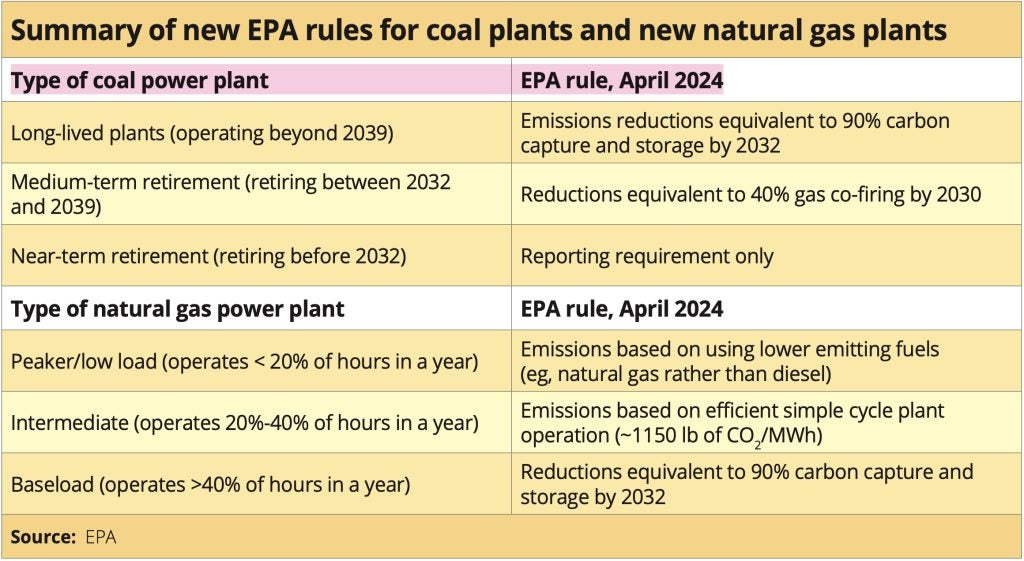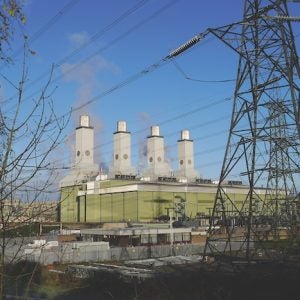
When combined with other policies like tax credits from the Inflation Reduction Act, the new rules should be able to reduce power plant emissions by an estimated 75% below 2005 levels by 2035, and 83% by 2040. The new rules are critical for reducing uncertainty in decision-making by utilities, regulators and others about investments in the power sector in the coming years.
In addition to new standards that address carbon dioxide emissions, EPA also announced new rules covering mercury, wastewater and coal ash disposal at power plants.
Here are four important things to know about the EPA’s new power plant rules:
• What do the EPA’s power plant rules require?
The new rules require existing coal plants and future natural gas plants to address carbon dioxide emissions in coming years. The requirements placed on coal plants depend on how long they expect to operate. For new gas plants, the required emissions controls will depend on how much they operate over the course of a year.
Coal plants that expect to operate beyond 2039 will have to reduce their carbon dioxide emissions by 90% by 2032, using carbon capture or other means, two years later than what was initially proposed in the draft rule released in May 2023.
Coal plants closing by 2039 will have to reduce their emissions 16% by 2030 (based on what’s achievable using 40% gas co-firing, though plants can use any technology they want to achieve the necessary reductions). Those plants scheduled to retire before 2032 are exempt from reducing emissions, but do have reporting requirements.
If fully implemented, these rules could lead to the closure of most of the USA’s coal plants — the country’s most polluting source of electricity — before 2040.
It is, however, important to recognise that coal-fired electricity generation has plummeted in the USA during the last few decades, from just over 50% of total generation in 1990 to 17% in 2022, due to both a surge in natural gas, wind and solar generation, as well as the introduction of regulations requiring cleaner generation. In the final rules, the EPA brought forward the retirement date that triggers the need for emissions controls for coal plants from 2040 to 2039, requiring a larger set of plants to control emissions if they extend their lifetimes beyond 2039.
While requirements for existing natural gas plants, which are responsible for more than 40% of US electricity generation today, will be addressed in a forthcoming rule covering a wider set of air pollutants, the current rule addresses three categories of new natural gas plants based on their hours of operation over the course of a year:
- For “baseload” plants that operate more than 40% of the time, EPA will require reductions that are the equivalent to 90% carbon capture and sequestration by 2032.
- For “intermediate” natural gas plants that operate 20%-40% of the time, the rules require them to meet a performance threshold corresponding to an efficient simple cycle plant, or 1150 pounds of CO2 per MWh.
- For peaker plants that operate less than 20% of the time, the rules require the use of lower-emitting fuels such as natural gas, which is already common practice, rather than diesel or high-emitting alternatives.
In addition to the greenhouse gas rule, EPA also finalised new rules strengthening and updating the Mercury and Air Toxics Standards (MATS) for coal-fired power plants, reducing pollutants discharged through wastewater from coal-fired power plants, and requiring the safe management of toxic coal ash left after burning coal for electricity.

• How can power plants comply with the new rules?
Since the US Supreme Court ruled in Massachusetts vs EPA in 2007 that the agency was responsible for regulating the emissions of carbon dioxide and other greenhouse gases as pollution under the Clean Air Act, EPA has attempted to craft regulations that are based on the “best system of emission reduction” (BSER) to comply with this directive.
The first attempt was in 2015 with the Obama-era Clean Power Plan, which proposed a systemwide approach to require carbon emissions reductions. Those regulations were halted by court challenges before full implementation and replaced by the Trump administration’s inaccurately named Affordable Clean Energy Rule in 2019. That rule proposed to raise pollution limits and lower efficiency measures, which would have resulted in more damage to human and environmental health. But it was also halted by the courts before taking effect.
The new rules put forward by the EPA focus on reducing emissions from individual facilities by employing traditional, at-the-source pollution control measures for carbon as well as other forms of pollution. At present, the best way to control carbon emissions at individual power plants is through carbon capture and storage (CCS).
Utilities planning to operate a plant beyond the 2030s can comply with the rule by using carbon capture technologies. If other kinds of technologies develop over time, utilities can use them given the compliance flexibility written into the final rules. The EPA estimates using CCS technology would slash 88% of the carbon dioxide emissions from power plants, preventing up to 1.38 billion metric tons of carbon dioxide emissions over the next 23 years, the equivalent of taking 328 million gasoline-powered cars off the road for a year.
Critics, including the Edison Electric Institute, have been quick to protest that CCS is not a fully mature technology ready for widespread deployment, and that it would be too expensive to widely deploy in order to comply by the 2032 deadlines. However, CCS was among the technologies that earned generous tax credits (known as provision 45Q) and research funding through the Inflation Reduction Act. These tax credits will provide utilities with a strong incentive to install the technology where it makes sense, reducing compliance costs for at least the next decade.
• Will the EPA’s new power plant rules be overturned or challenged?
The new rules are expected to face myriad challenges from Congress, the courts and potentially from future administrations.
Before the final rules were even officially announced, members of Congress indicated they plan to use a legislative tool called the Congressional Review Act, which only requires a simple majority to pass, in an effort to overturn the rules. However, in the current 118th Congress, such attempts would likely be vetoed upon landing on President Joe Biden’s desk. Chances of a two-thirds majority in both chambers voting to override the veto are also slim.
Efforts to overturn these rules in the next Congress hinge on when the rules were officially published in the Federal Register (7, 8 and 9 May 2024), as any rule finalised within 60 working days of the new Congress could be subject to additional review and votes.
The rules are being challenged in the courts, and the outcomes are uncertain. Various states’ attorneys general, led by West Virginia’s Attorney General Patrick Morrisey, began to challenge the new rules as soon as they were published in the Federal Register. Utilities and other companies who see themselves impacted by the new rules are joining in legal filings. The Edison Electric Institute, representing investor-owned utilities, has filed an appeal on the basis, as already noted, that CCS technology has not been adequately demonstrated for broad deployment currently. Duke and AEP have also appealed.
Such legal challenges would likely end up at the Supreme Court, just as the Obama-era Clean Power Plan rules did in West Virginia vs EPA. In that 2022 ruling, the Supreme Court declared that EPA could not force utilities to meet future regulations by requiring them to shift generation to different sources (eg, replacing coal with gas or wind), but must rely instead upon the best system of emissions reductions that can be applied on a plant-by-plant basis, which is the path EPA has attempted to follow with these new rules.
In addition to challenges from Congress and the courts, a change of presidential administration would threaten power plant rules. Former President Donald Trump, who is the presumptive Republican nominee for the 2024 election, has promised to roll back these and other climate-focused regulations if elected.
• What’s missing from the new EPA power plant rules?
While these rules will address various forms of pollution from the oldest and dirtiest sources of electricity generation, they do not address the largest source of current carbon pollution in the electricity sector: existing natural gas power plants.
EPA has delayed regulatory standards for existing gas plants, indicating that the rule-making process could begin in 2025 and include control of other air pollutants as well. This could strengthen the regulations and make them potentially less vulnerable to legal challenges.
While the new rules were both weakened and strengthened in certain areas compared to the 2023 draft rule, the emissions performance standards were substantially watered down for intermediate natural gas plants that operate from 20% to 40% of the time. Under the draft rules, these plants would have needed to reduce emissions to a rate of about 1000 pounds of CO2/ MWh by 2030 based on blending 30% hydrogen fuel with natural gas.
The removal of the requirement based on hydrogen co-firing and only limiting emissions to those equivalent to a simple cycle turbine is a substantial weakening of the rule for these plants. While the maximum operation of plants in this category was reduced to 40% from 50% in the draft rule, which would reduce the number of qualifying plants and the amount of generation that could come from this category of plants, the emissions standards should be revisited and strengthened in the future.
As World Resources Institute wrote last spring when the draft rule was first proposed, achieving faster and deeper reductions from coal- and gas-fired power plants is the most important thing the United States can do to build on the Inflation Reduction Act and achieve the national target of reducing emissions to 50%-52% below 2005 levels by 2030. It’s critical for the federal government to take additional actions to accelerate the construction of zero-emissions generation, energy storage and transmission capacity. The Biden administration should continue enacting its action plan for quicker, smarter permitting of this essential infrastructure. Congress, along with state and local governments, must also continue to encourage more effective community engagement while eliminating duplicative processes that create delays without improving decision-making.
SOURCE: 4 things to know about US EPA’s new power plant rules, by Dan Lashof, Lori Bird and Jennifer Rennicks, World Resource Institute Insights channel, https://www.wri.org/insights/epa-power-plant-rules-explained






